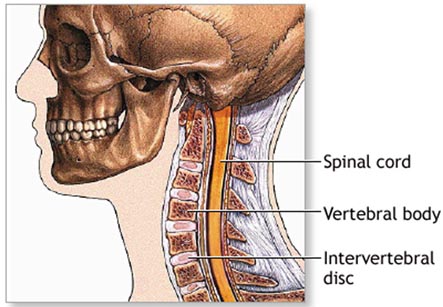Cervical Spine Surgery
Introduction
Cervical spine surgical treatment options can vary. Before making a decision about which option is most suitable, the surgeon takes into account the specific cervical spine pathology of the patient, clinical signs, symptoms, and other factors such as general medical, biomechanical and technical considerations. The choice also depends on the current medical advances and the surgeon’s personal expertise and preferences.
Procedure:
Surgical treatment for the patient with a cervical radiculopathy is indicated in patients with
• Persistent signs and symptoms, despite more than 6 weeks of appropriate nonsurgical or conservative treatment or
• A progressive motor deficit with confirmed radiographic correlation.
Iran has made significant progress in neurosurgery and The world renowned Iranian scientist in neurological surgery Professor Majid Samii has garnered the 2014 Golden Neuron Award. We have all the information you need about public and private clinics and hospitals that provide Neurosurgical surgeries in Iran, Islamic Republic Of with the best quality and lowest possible price

Surgical approaches for cervical radiculopathy include anterior cervical discectomy with or without fusion and posterior lamino-foraminotomy. In patients with myelopathy who require spinal cord decompression;the procedures can be anterior cervical discectomy, anterior cervical corpectomy (single or multiple levels) with fusion, laminectomy with or without fusion, and laminoplasty. Occasionally, a combination anterior as well as posterior approach is necessary. Surgical treatment for the other problems is case specific. Currently, a comprehensive, evidenced-based medical resource for the choice of cervical spine surgical treatment does not exist.
Many factors are considered by the surgeon prior to offering any surgery. While discussing the surgery options with the patient, the following points may be discussed:
• The details of operation
• Graft material
• Instrumentation
• Risks involved
• Benefits of the procedure
• Potential complications
• Alternatives, if any
Cervical spine surgery is generally performed on an elective basis to treat either:
• Nerve/spinal cord impingement, which is called as decompression surgery
• Spinal instability, which is fusion surgery.
The two procedures are often combined, as a decompression surgery may de-stabilize the spine and create the need for a fusion for stability. Spinal instrumentation (such as insertion of a small plate) can also be used to add stability to the spinal construct.
The cervical spine can either be approached from the front (anterior approach) or from the backside (posterior approach). In general, wherever possible, most surgeons prefer an anterior approach for most conditions. The reasons for this preference is that the anterior approach results in less disruption of the normal muscles and it is also easier to maintain the normal alignment of the spine in this approach.
For example, many degenerative conditions of the spine can cause a loss of the normal lordosis (gentle curvature of the spine). However, by opening up the front of the spine, this lordosis can be re-established.
Also, there are some conditions that do require a posterior approach or a combined anterior as well as posterior approach.
A cervical disc herniation can be repaired or removed through an anterior approach (through the front of the neck) to relieve pressure on spinal cord or nerve root and alleviate corresponding symptoms such as pain, weakness, numbness and tingling.
• This procedure is called as an anterior cervical discectomy and allows the offending disc to be surgically removed. A discectomy is in fact a form of surgical decompression. Therefore, the procedure may also be called as an anterior cervical decompression.
• A fusion surgery is almost always done along with the discectomy in order to stabilize the cervical segment of spine.
• The combined surgery is commonly referred to as an ACDF surgery, which means Anterior Cervical Discectomy and Fusion.
While this surgery is most commonly performed to treat a symptomatic cervical herniated disc, it may also be done for cervical degenerative disc disease. This procedure may also be suitable for more than one level of the cervical spine.